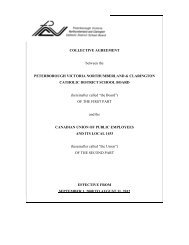Privatization of Public Services: What does it Mean for Women
Privatization of Public Services: What does it Mean for Women
Privatization of Public Services: What does it Mean for Women
You also want an ePaper? Increase the reach of your titles
YUMPU automatically turns print PDFs into web optimized ePapers that Google loves.
In the area <strong>of</strong> health care, CUPE follows closely what is happening w<strong>it</strong>h privatelyfinanced hosp<strong>it</strong>als in the UK. It uses horror stories from the UK experience to argueagainst embracing this model <strong>of</strong> privately financing, owning, and operating hosp<strong>it</strong>als andother public inst<strong>it</strong>utions in Canada. CUPE is also mon<strong>it</strong>oring the struggle againstprivatizing our municipal water systems, as part <strong>of</strong> a global struggle by unions, c<strong>it</strong>izengroups, environmental activists, women’s groups, and social justice organizations.From Keynesian welfare state to neo-liberal state<strong>Privatization</strong> is a general term that covers many specific practices whereby publicservices are reduced and the private sector takes on a much larger role in their financingand delivery. Private financing <strong>of</strong> public services may take the <strong>for</strong>m <strong>of</strong> individuals payingmore <strong>for</strong> public services, <strong>for</strong> example through user fees, rather than having the costscovered by taxes. It also includes encouraging corporations to pay <strong>for</strong> developing orrenewing the infrastructures <strong>of</strong> public inst<strong>it</strong>utions such as hosp<strong>it</strong>als and schools.Governments like this <strong>for</strong>m <strong>of</strong> public-private partnership because <strong>it</strong> reduces public debteven though <strong>it</strong> costs more in the long term and <strong>of</strong>ten means loss <strong>of</strong> public ownership andcontrol. Probably the most common <strong>for</strong>m <strong>of</strong> private delivery is the transfer or subcontracting<strong>of</strong> the operation <strong>of</strong> a public service, such as the cleaning <strong>of</strong> a school orhosp<strong>it</strong>al, to a private company. A gendered perspective reveals another important <strong>for</strong>m<strong>of</strong> privatization — the transfer <strong>of</strong> paid, public-service work, which is mainly provided bywomen, to the private sphere <strong>of</strong> women’s unpaid, care-giving work in the home.<strong>Privatization</strong> undermines a key element <strong>of</strong> the Keynesian welfare state — the notion <strong>of</strong>collective, social, or public responsibil<strong>it</strong>y; argue Brenda Cossman and Judy Fudge intheir book on women and privatization. This is replaced by a market system based onlabour flexibil<strong>it</strong>y and individual self-reliance. The trans<strong>it</strong>ion to a neo-liberal state affectswhat we think <strong>of</strong> as public and private, especially in the relationship between privatehouseholds and the state. As the state w<strong>it</strong>hdraws or weakens public services in favour<strong>of</strong> greater individual responsibil<strong>it</strong>y, labour costs are lowered through women’s unpaiddomestic labour, job cuts, and contracting out.The post-World War II period to the early 1970s saw tremendous growth in publicservices such as health care, education, social services, and childcare. Many womenwere hired to provide these public services, not only because the strong growth <strong>of</strong> theeconomy required more workers to enter the paid labour <strong>for</strong>ce but also because thesenew jobs resembled women’s unpaid work in the home. The Keynesian welfare stateassumed responsibil<strong>it</strong>y <strong>for</strong> some previously unpaid work, primarily <strong>of</strong> women in thehome, and <strong>it</strong> expanded the range <strong>of</strong> services available. Thanks to collective ef<strong>for</strong>ts onthe part <strong>of</strong> unions, such public sector jobs became a source <strong>of</strong> good jobs <strong>for</strong> Canadianwomen workers.In Canada, as in many countries, public-sector jobs, including health care, education,and some social services, are the main source <strong>of</strong> unionized jobs <strong>for</strong> women. Feministand union organizing has significantly raised wages in the public sector above theprivate sector norm <strong>for</strong> women, and has improved benef<strong>it</strong>s such as pension plancoverage, paid sick leave, and vacations. As a result, unionized women in Canadamake, on average, $5.44 an hour more than their non-union sisters. And over two-thirds<strong>of</strong> women in the public sector have a pension, compared to fewer than one-third <strong>of</strong>women in non-union jobs.2

















